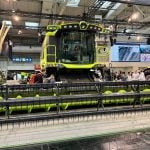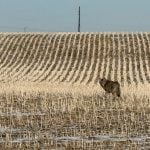To engage government employees in agriculture and agtech, the Association of Equipment Manufacturers (AEM) got them out of the office and onto the farm to see technology in farming up close.
Why it matters: The demonstration day offered the opportunity for employees in agriculture-related ministries to see technology on farms.
Over 100 guests from government ministries including Agriculture and Agri-Food Canada and the Pest Management Regulatory Agency convened Aug. 20 at Blackrapids dairy farm just outside Ottawa for a demonstration day, hosted by AEM. Attendees spent the morning rotating between six stations where representatives from equipment companies explained the function of their tech.
Read Also

Lactanet turns methane expertise into business opportunity
Lactanet’s new fee-for-service breeding tool initiative to reduce greenhouse gas emissions in Canadian and Swiss Holstein herds will launch in April 2026.
A goal of the day was to engage governments directly in the hopes of expanding financial support for agricultural technology and equipment manufacturing in Canada.
Host farmer Peter Ruiter said he was excited to have the opportunity to open his farm up and tell his story.
“I never turn away a chance to teach people where food comes from,” he said. “I think more farmers should do it. I think we’re in our own little world, we know our industry really well. We don’t do a very good job telling our story.”
Ruiter explained how it can be different speaking with government employees versus fellow farmers.
“I try to put it into their language,” he said.
“I use the collar around the cow and say it’s a Fitbit. It’s very much similar to a Fitbit. We put the cows through a ‘mani and a pedi.’ It’s really a foot bath for the cow. People understand, and I try to relate to them as they would relate to it.”
“The main thing they come away with is that we care,” he said, “and whether you’re a crop farmer, a dairy farmer or a pig farmer or whatever farmer you are, we care.”
Anson Boak, marketing manager for Salford, presented a vertical tilling system with colleagues. He said there is “a base level of knowledge” about the technology and the payback of things like variable-rate when talking to farmers and equipment dealers that isn’t always present in those outside the sector.

“There was a lot of interest in the efficiency of the business and just wanting to understand, how much does variable-rate fertilizer benefit a farmer? What are the trade-offs of planting cover crops versus not doing that?”
Vincent Audet, a territory manager for Kuhn, who was displaying a broadcast fertilizer spreader, said speaking to farmers versus governments requires the same explanation but with a different perspective.
“When you’re talking to a farmer, he’s worried about his operation. He wants the operation to make money,” he said. “Then they want to pass the land on to the next generation. In most cases, that’s their goal. But still, they need to keep it profitable to be able to do that.”
“When you speak to people in the government agencies or that are not involved directly with agriculture, they’re interested in how agriculture affects the rest of society. So, you need to basically use the same arguments. It’s the same explanation. It’s the same thing, but from a different perspective.”
Tony Brazda and Mark Rose of Lely Canada presented a robotic cattle feeding system, which can accommodate the cow depending on when it is ready to be milked, fed or groomed. Brazda said attendees were most interested in the system’s cost-saving potential.
“There’s considerable labour savings to be had, increased productivity, it struck home with a lot of people.”
Rose said many guests were surprised to see in action the choices cows can make on their own.
“There’s a lot of people just think that we dictate when she has to do things. Hopefully what they got out of today was seeing inside the barn, we basically free-feed when she wants to be fed. She can (lie) when she wants to (lie), milk when she wants to milk, and she’ll be relaxed when she wants to relax.”
Boak said he hoped the day could lead to better understanding of how the government can make best practices easier for farmers.
“Every farmer has stewardship in mind at some point, but they’re also business people, and there’s economic trade-offs to some of the practices,” he said.
So if government can help with best practices and in a way that continues to be a net positive for the farm business, then that would be absolutely the best thing we could achieve.”
Rose said he hoped to see “a more accurate realization of what actually is going on in the field and where innovation is growing in agriculture.”
Brazda echoed the sentiment.
For Audet, the important message to get across was that if the government wants farmers to adapt and shoulder more burden, it must first understand what their operations really look like.
“They want behaviours to change to meet certain targets, like (reducing) greenhouse gas emissions. There’s different ways to do that and when you want to influence farmers to do things differently, you have to help them, but you have to help them while you understand what the farmer’s motives are.”
Audet said if government wants a farmer to reduce emissions or reduce pollution, devising a new set of rules is not necessarily going to meet that objective.
“You need to help them change habits and find a better way to do things, rather than imposing just stricter regulations. Not just ‘here’s a new technique, it’s been proven to be profitable. If you do this, you will be profitable.’”

Ruiter said he would happily host again given the opportunity. He said public outreach and farm tours have been a regular effort for him.
“Most people come through, and they’re just amazed that I care and, and that’s disheartening for me, because I think you talk to any farmer and they care.”
He said he sees the day having a lasting impact on the government employees who attended.
“It opens your door saying, well, this is what agriculture is. It’s not pitching bales with a hay fork anymore. Or, you know, it’s not milking cows by hand,” he said.
“It’s milking cows with robots, feeding cows with robots, putting on fertilizer exactly where it’s required, exactly on time. It’s tillage equipment that’s designed to be vertical. All those are things coming down the line. And if these guys have 10 or 15 years left in the in the industry in a policy role, that can spell dividends forever, because they’ll pass it on to the next person.”















